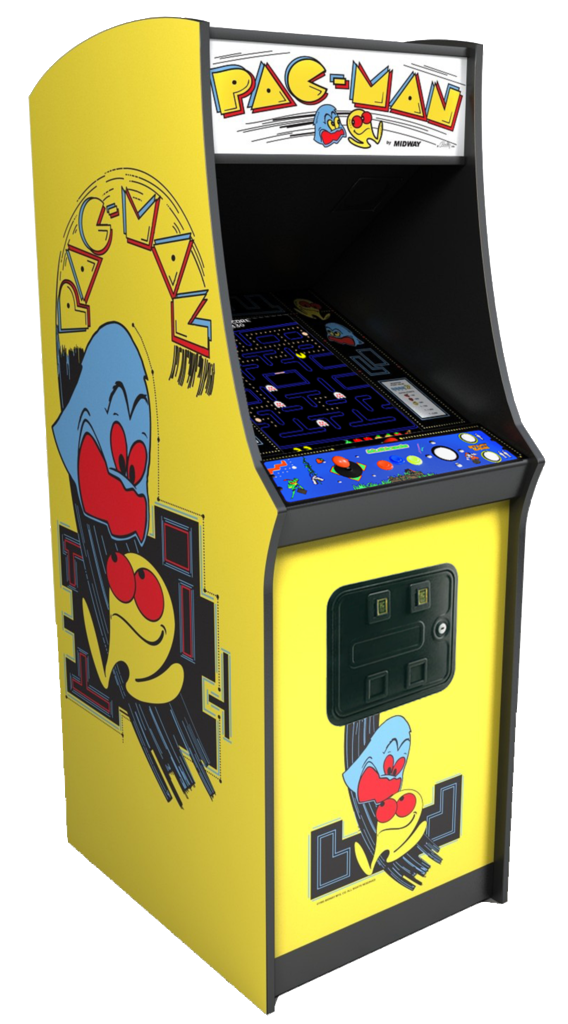Pacman

Pac-Man, stylized as PAC-MAN, is an arcade game developed by Namco and first released in Japan as Puck Man in May 1980. It was created by Japanese video game designer Toru Iwatani. It was licensed for distribution in the United States by Midway Games and released in October 1980. Immensely popular from its original release to the present day, Pac-Man is considered one of the classics of the medium, and an icon of 1980s popular culture. Upon its release, the games and, subsequently, Pac-Man derivatives became a social phenomenon that yielded high sales of merchandise and inspired a legacy in other media, such as the Pac-Man animated television series and the top-ten Buckner and Garcia hit single "Pac-Man Fever". The game was popular in the 1980s and 1990s and is still played in the 2010s.
 When Pac-Man was released, the most popular arcade video games were space shooters in particular, Space Invaders and Asteroids. The most visible minority were sports games that were mostly derivatives of Pong. Pac-Man succeeded by creating a new genre. Pac-Man is often credited with being a landmark in video game history and is among the most famous arcade games of all time. It is also one of the highest-grossing video games of all time, having generated more than $2.5 billion in quarters by the 1990s.The Google Doodle version of Pac-Man was estimated to have been played by over 1 billion people worldwide in 2010.Adjusted for inflation, all versions of Pac-Man are estimated to have grossed over $12 billion in total revenue.
When Pac-Man was released, the most popular arcade video games were space shooters in particular, Space Invaders and Asteroids. The most visible minority were sports games that were mostly derivatives of Pong. Pac-Man succeeded by creating a new genre. Pac-Man is often credited with being a landmark in video game history and is among the most famous arcade games of all time. It is also one of the highest-grossing video games of all time, having generated more than $2.5 billion in quarters by the 1990s.The Google Doodle version of Pac-Man was estimated to have been played by over 1 billion people worldwide in 2010.Adjusted for inflation, all versions of Pac-Man are estimated to have grossed over $12 billion in total revenue.
 The character has appeared in more than 30 officially licensed game spin-offs, as well as in numerous unauthorized clones and bootlegs. According to the Davie-Brown Index, Pac-Man has the highest brand awareness of any video game character among American consumers, recognized by 94 percent of them. Pac-Man is one of the longest-running video game franchises from the golden age of video arcade games. It is part of the collection of the Smithsonian Institution in Washington, D.C. and New York's Museum of Modern Art.
The character has appeared in more than 30 officially licensed game spin-offs, as well as in numerous unauthorized clones and bootlegs. According to the Davie-Brown Index, Pac-Man has the highest brand awareness of any video game character among American consumers, recognized by 94 percent of them. Pac-Man is one of the longest-running video game franchises from the golden age of video arcade games. It is part of the collection of the Smithsonian Institution in Washington, D.C. and New York's Museum of Modern Art.
The enemies in Pac-Man are known variously as "monsters" or "ghosts". Despite the seemingly random nature of the enemies, their movements are strictly deterministic, which players have used to their advantage. In an interview, creator Toru Iwatani stated that he had designed each enemy with its own distinct personality in order to keep the game from becoming impossibly difficult or boring to play. More recently, Iwatani described the enemy behaviors in more detail at the 2011 Game Developers Conference. He stated that the red enemy chases Pac-Man, and the pink enemy aims for a position in front of Pac-Man's mouth.[30] The blue enemy is "fickle" and sometimes heads towards Pac-Man, and other times away. Although he claimed that the orange enemy's behavior is random, in actuality it alternates from behaving like the red enemy when at some distance from Pac-Man and aiming towards the lower-left corner of the maze whenever it gets too close to him.
Although Midway's 1980 flyer for Pac-Man used both the terms "monsters" and "ghost monsters", the term "ghosts" started to become more popular after technical limitations in the Atari 2600 version caused the antagonists to flicker and seem ghostlike, leading them to be referred to in the manual as "ghosts", and they have most frequently been referred to as ghosts in English ever since.

